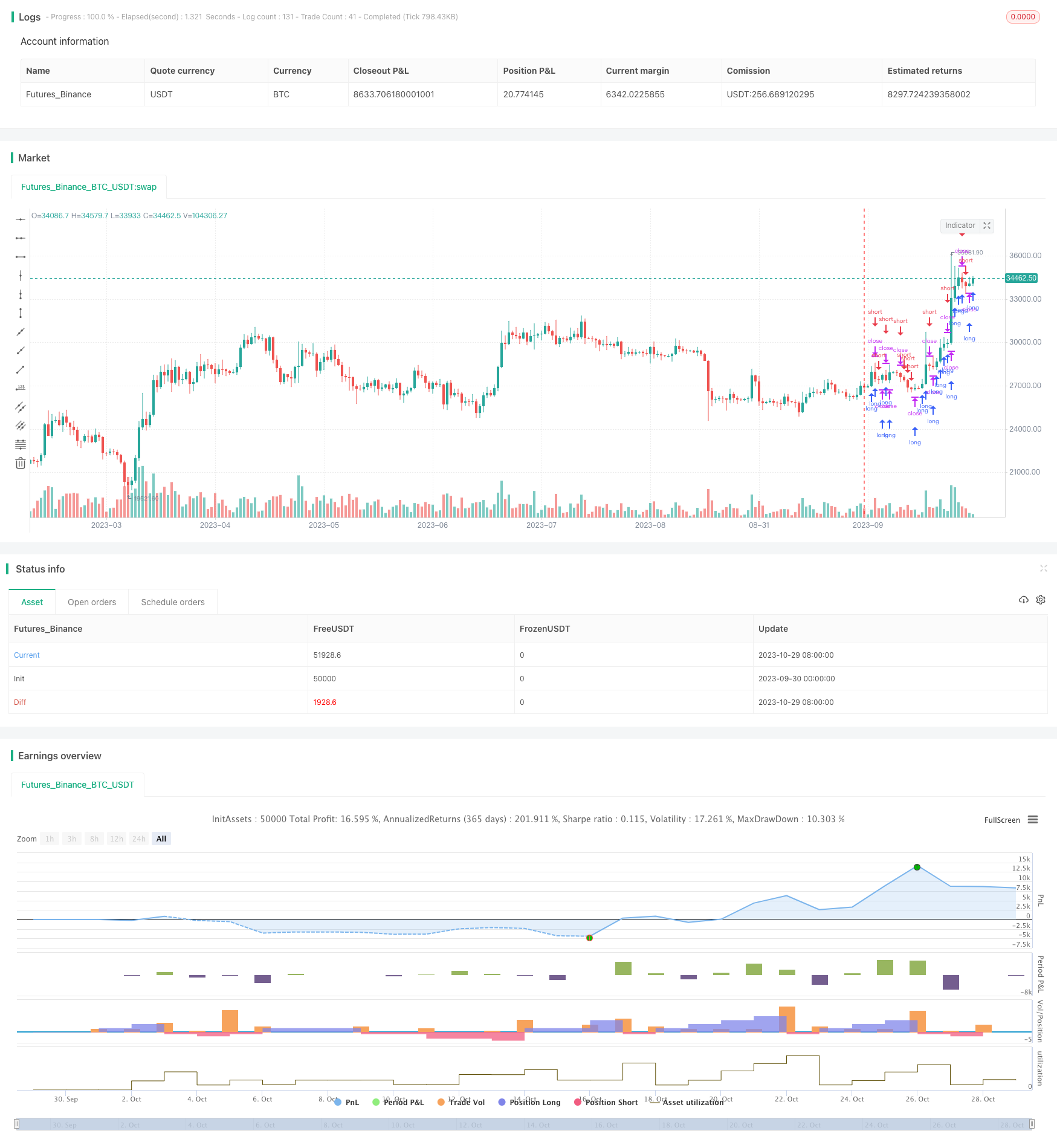
概述
该策略是一个基于ATR指标的趋势突破策略。它的主要思想是当价格超过一定倍数的ATR时,进行趋势突破操作。策略同时包含趋势的确认以及利用日期范围进行限制交易的功能。
原理
策略使用ATR指标判断价格波动幅度。ATR表示平均真实波幅,它测量某一时间周期内的平均价格波动幅度。策略中设置length参数计算ATR周期,numATRs参数表示突破的ATR倍数。
当价格上涨突破上方numATRs倍ATR时,进行做多操作;当价格下跌突破下方numATRs倍ATR时,进行做空操作。
此外,策略加入需要长仓(needlong)和需要做空(needshort)的BOOL变量,可以控制只做多或只做空。策略还设置了日期范围,只在指定日期之间进行交易,从而实现时间范围限制。
策略使用size变量判断仓位,根据仓位情况计算下单手数。手数按照账户权益的百分比计算。
优势
- 使用ATR指标自动适应市场波动率,无须人工设置止损止盈距离
- 可灵活选择做多做空或只做多/空
- 可设定日期范围进行交易,避开重要时间点
- 手数设置灵活,可按账户权益百分比下单
风险及解决
- ATR指标仅考虑价格波动,如果行情出现剧烈变化,止损距离可能太小,需要组合其他指标优化
- 日期范围限制交易时,如果重要时间段前后没有合适机会,可能导致错失交易机会,可以适当扩大日期范围
- 使用账户权益比例下单时,需要合理设置比例,避免单笔损失过大
优化思路
- 可以考虑加入移动平均线等趋势指标,以过滤掉非趋势突破带来的噪声交易
- 可以测试不同的ATR周期参数,选取最佳参数组合
- 可以考虑与其他策略组合使用,发挥各自优势,改善策略稳定性
总结
本策略整体思路清晰易懂,使用ATR指标自动适应市场波动性,是一种通用的趋势跟踪策略。通过参数优化以及组合其他策略,可以进一步改善策略表现和稳定性。但需要注意防止单笔损失过大,并留意行情剧烈变化时的止损不足问题。
策略源码
/*backtest
start: 2023-09-30 00:00:00
end: 2023-10-30 00:00:00
period: 1d
basePeriod: 1h
exchanges: [{"eid":"Futures_Binance","currency":"BTC_USDT"}]
*/
//Noro
//2018
//@version=3
strategy(title = "Noro's Volty Strategy v1.0", shorttitle = "Volty 1.0", overlay = true, default_qty_type = strategy.percent_of_equity, default_qty_value = 100, pyramiding = 100)
//Settings
needlong = input(true, defval = true, title = "Long")
needshort = input(false, defval = false, title = "Short")
capital = input(100, defval = 100, minval = 1, maxval = 10000, title = "Lot, %")
length = input(5)
numATRs = input(0.75)
fromyear = input(1900, defval = 1900, minval = 1900, maxval = 2100, title = "From Year")
toyear = input(2100, defval = 2100, minval = 1900, maxval = 2100, title = "To Year")
frommonth = input(01, defval = 01, minval = 01, maxval = 12, title = "From Month")
tomonth = input(12, defval = 12, minval = 01, maxval = 12, title = "To Month")
fromday = input(01, defval = 01, minval = 01, maxval = 31, title = "From day")
today = input(31, defval = 31, minval = 01, maxval = 31, title = "To day")
//Indicator
atrs = sma(tr, length) * numATRs
//Trading
size = strategy.position_size
lot = 0.0
lot := size == 0 ? strategy.equity / close * capital / 100 : lot[1]
if (not na(close[length])) and needlong
strategy.entry("L", strategy.long, lot, stop = close + atrs, when = (time > timestamp(fromyear, frommonth, fromday, 00, 00) and time < timestamp(toyear, tomonth, today, 23, 59)))
if (not na(close[length])) and needlong == false
strategy.entry("L", strategy.long, 0, stop = close + atrs, when = (time > timestamp(fromyear, frommonth, fromday, 00, 00) and time < timestamp(toyear, tomonth, today, 23, 59)))
if (not na(close[length])) and needshort
strategy.entry("S", strategy.short, lot, stop = close - atrs, when = (time > timestamp(fromyear, frommonth, fromday, 00, 00) and time < timestamp(toyear, tomonth, today, 23, 59)))
if (not na(close[length])) and needshort == false
strategy.entry("S", strategy.short, 0, stop = close - atrs, when = (time > timestamp(fromyear, frommonth, fromday, 00, 00) and time < timestamp(toyear, tomonth, today, 23, 59)))